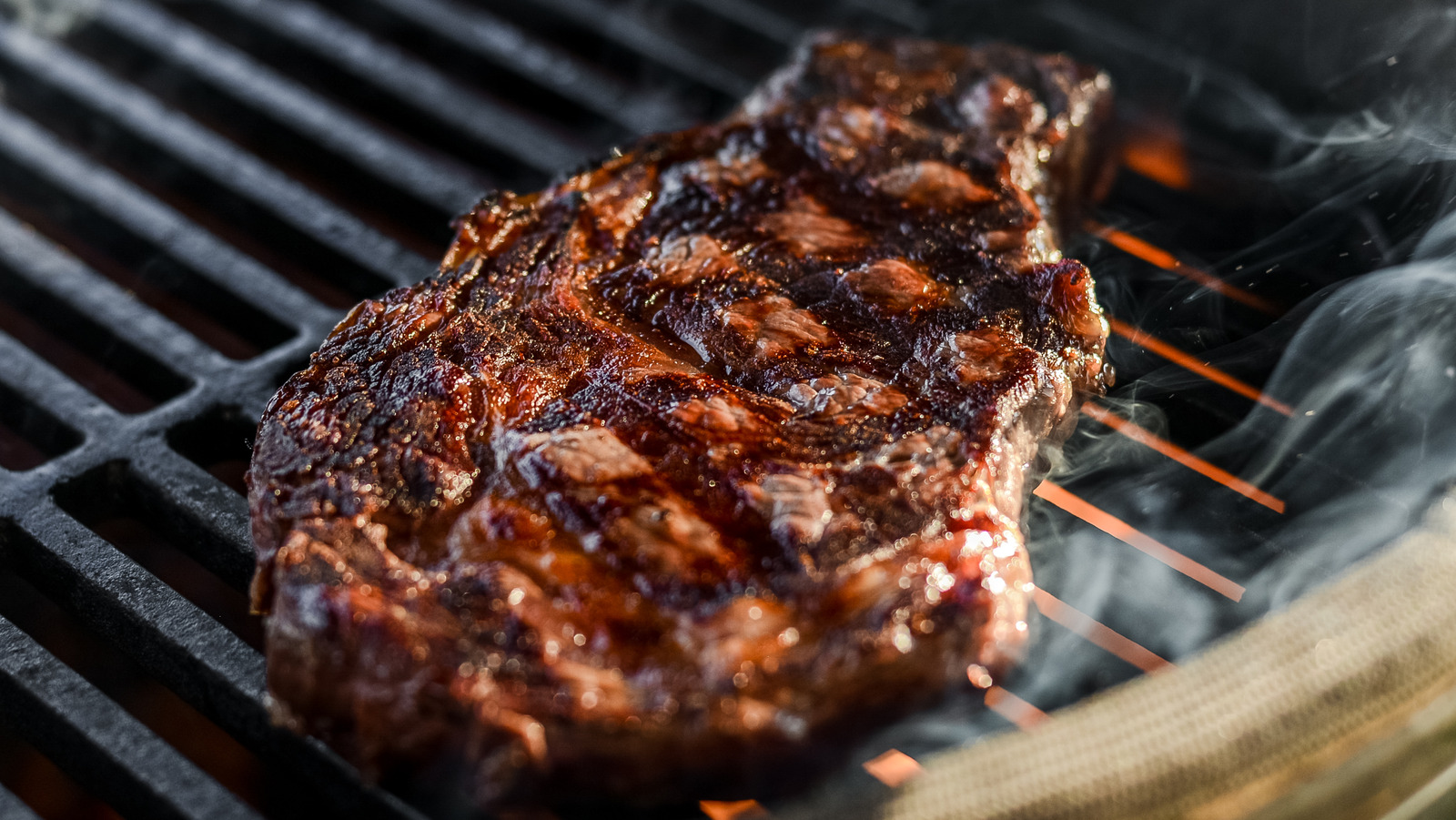The Clever Bowl Hack To Keep Crust In Tact While Resting Steak – Tasting Table

The Clever Bowl Hack To Keep Crust In Tact While Resting Steak – Tasting Table
One of the marks of a perfectly cooked steak is a great, crispy crust. Just as important, however, is the resting period you give it after it comes off the heat. Resting allows the meat to relax and evenly redistributes the juices to give you a beautifully tender and juicy steak. If you’re not careful, though, resting can wreak havoc on your crust. Fortunately, there is a simple hack to prevent this from happening that involves a small bowl.
It’s not uncommon for us to rest our freshly cooked steaks directly on a plate or cutting board. The downside of this method though is that the juices from the beef will leak out onto the surface and become reabsorbed into the meat. This ruins the beautiful crust you worked so hard to build.
To avoid this outcome, take a small bowl, one that’s no wider than your steak is long, and rest the meat on the rim. The escaping juices will pool in the bowl instead of around the steak. Not only will this keep the crispy exterior intact, but the bowl provides a basin in which to catch the juices, which you can use to make a fantastic sauce. But none of this will matter unless you get yourself a good crust first.
Tips for great steak crust
 Tatiana Volgutova/Shutterstock
Tatiana Volgutova/Shutterstock
Before you even think about resting your steak on top of a bowl, you need to get that crust right. One of the greatest ways to ensure a crispy exterior is to make sure that you’ve bought meat that’s the right size. Thicker steaks are easier to get a crust on while also keeping the interior tender and medium-rare. The optimal thickness for cuts like ribeyes and porterhouses is between 1.5 to 2 inches. It’s also important to have a hot surface on which to cook your beef.
You could do this on the grill, but a cast iron skillet is the better option. The flat tip of the skillet provides more surface area for the steak to develop its crust. Heat is important because it shocks the meat into developing a browned exterior without overcooking it on the inside. Other ways to ensure the ideal crispiness on the outside are to pat your beef dry, use plenty of salt, a dry rub, or just lightly flour your steak. Just remember to keep that bowl on hand so you don’t unintentionally ruin that crust you worked so hard to build.
Related News & Content
-

Limit taxonomy terms added to a custom post type
Limit taxonomy terms added to a custom post type,I've created a Custom Post Type and a Custom Taxonomy. In WP Admin, how can I limit amount of taxonomy terms that are added to the custom post type? I want to add no more than one tag into the post. Tags: custom post types custom taxonomy limit stackexchange.com WordPress Development Stack Exchange -

Query top level custom post in taxonomy
Query top level custom post in taxonomy,This is my first post, I'm a bit stuck. I have a custom post (dan) and taxonomy (dnas), with hierarchical categories. I want to make a query resulting in posts at toplevel (hoofdcategorie01, Tags: stackexchange.com taxonomy WordPress Development Stack Exchange wp query -

Gutenberg: Restrict Top Level Blocks, But Not Child Blocks
Gutenberg: Restrict Top Level Blocks, But Not Child Blocks,Background I've created a custom top level "page section" block, to work with my existing theme. I've like to restrict top level blocks to ONLY that one block. However, I don't want to di... Tags: block editor stackexchange.com WordPress Development Stack Exchange -

How do I load styles into the block editor admin screen?
How do I load styles into the block editor admin screen?,The core file 'load-styles.php' generates css styles. Some of the styles interfere with the block editor. I would like to pass in my own style rules that override the styles generated by 'load-styl... Tags: block editor stackexchange.com WordPress Development Stack Exchange -

Installing WordPress in a subdirectory
Installing WordPress in a subdirectory,I am trying to install wordpress into a subdirectory of a website. I simply want to build the client's new site in this subdirectory, so a separate and new WP install in this subdirectory, and the... Tags: installation stackexchange.com WordPress Development Stack Exchange -

Custom theme and plugin updating
Custom theme and plugin updating,History: I'm working on a project for a client that involves building 27 unique websites that are built on wordpress. I say unique, because (for reasons that are not worth going into here) they ar... Tags: automatic updates plugin development stackexchange.com theme development WordPress Development Stack Exchange -

Rewrite nested urls for custom post type
Rewrite nested urls for custom post type,I have a problem with nested permalink. I have a structure of urls like that: Catalog -> Category -> Product My urls are: www.domain.com/catalogs (for archive catalog) www.domain.com/catal... Tags: custom post types stackexchange.com url rewriting WordPress Development Stack Exchange -

Ajax not working to insert, query and result data
Ajax not working to insert, query and result data,On my site, through a form I send/register same information in database, do a SELECT/query and return it! Return the last table saved in database, just that user just entered on the form (along wit... Tags: Ajax database functions plugin development stackexchange.com WordPress Development Stack Exchange -

Israel at war, day 204: Hamas airs video of Israeli hostages, one with U.S. citizenship
Israel at war, day 204: Hamas airs video of Israeli hostages, one with U.S. citizenship,Hamas Studying Israel's Response to Position on Cease-fire Talks Gaza Aid Shipments Resume From Cyprus IDF: Two Palestinians Killed After Firing on IDF Outpost in the West Bank Pro-Palestinian Protest Leader Banned From Columbia Campus Here's What You Need to Know 204 Days Into the War Tags: 2023 Israel Gaza War haaretz.com Israel News -

Carol Kirkwood stuns in figure-hugging dress amid BBC Breakfast technical chaos
Carol Kirkwood stuns in figure-hugging dress amid BBC Breakfast technical chaos,CAROL Kirkwood stunned in a figure-hugging dress amid a technical blunder. BBC Breakfast was flung into chaos this morning after a string of sound issues. However Carol, 61, was all smiles as she p… Tags: BBC BBC Breakfast BBC ONE Carol Kirkwood mirror.co.uk The Scottish Sun TV News TV UK daytime TV -

Families ‘to sue prison’ where loud inmates ‘terrorise kids’ with screaming
Families 'to sue prison' where loud inmates 'terrorise kids' with screaming,Residents living next door to a new prison who say their kids have to sleep wearing headphones and some leave during weekends due to the racket are threatening to sue the prison service Tags: mirror.co.uk Neighbours from hell prisons Scottish government The Mirror -

Doctor Strange’s Secret Wars Role May Be More Important Than You Thought – Looper
Doctor Strange's Secret Wars Role May Be More Important Than You Thought - Looper,According to entertainment leaker Alex Perez, Doctor Strange will find himself confronting his inner struggles as he headlines "Avengers: Secret Wars." Tags: Fiction Looper looper.com Marvel Cinematic Universe Science Star Wars The Universal Monsters franchise -

Choctaw artist Jeffrey Gibson confronts history at US pavilion as its first solo Indigenous artist
Choctaw artist Jeffrey Gibson confronts history at US pavilion as its first solo Indigenous artist,Jeffrey Gibson’s takeover of the U.S. pavilion for this year’s Venice Biennale contemporary art show is a celebration of color, pattern and craft Tags: 109377793 abcnews.go.com Article Entertainment General news Indigenous people Keycat Keytags Race and ethnicity U.S. News visual arts World news -

Mexican film wins top prize at Moscow International Film Festival while major studios boycott Russia
Mexican film wins top prize at Moscow International Film Festival while major studios boycott Russia,A Mexican film has won the top prize at the Moscow International Film Festival which took place as major Western studios boycott the Russian market and as Russia’s war in Ukraine grinds into its third year Tags: 109702159 abcnews.go.com Article Entertainment Fairs and festivals General news Keycat Keytags Movies Russia Ukraine war World news -

International Jazz Day: How you can celebrate in Europe
International Jazz Day: How you can celebrate in Europe,What is International Jazz Day, and which modern European jazz artists should be on your radar? Tags: euronews euronews.com jazz Music Unesco -

The best things to do and see (or watch) in Europe this week
The best things to do and see (or watch) in Europe this week,The last Caravaggio, St. Vincent's new album and sexy tennis love triangles in Luca Guadagnino 'Challengers'. Tags: Cinema Culture Digest euronews euronews.com Exhibition Music Netflix TV Series -
Meta stock falls: Why the company's results failed to cheer investors
Meta stock falls: Why the company's results failed to cheer investors,The Facebook parent company, Meta Platforms, reported first-quarter earnings that topped market expectations. However, its shares plunged 15% due to weaker-than-expected second-quarter revenue guidance and an increased spending plan for artificial intelligence. -
Intended highlight of the 2024 Consumer Summit was completely omitted.
Intended highlight of the 2024 Consumer Summit was completely omitted.,A European Commission initiative aimed to let Big Tech companies voluntarily commit to a "cookie pledge", which would allow consumers to make effective choices regarding tracking-based advertising models, has failed to gain traction, a Commission spokesperson told Euronews. Tags: confidentiality of personal data Data Data Protection euronews euronews.com Lobbying firm
Warning: file_get_contents(https://www.scienceradars.com/wp-output-content.php?pg=1&cat=&kw=&lvl=): Failed to open stream: HTTP request failed! HTTP/1.1 526 in /home/wwwroot/xuenou.com/wp-content/themes/chromenews/template-parts/content.php on line 169
Warning: file_get_contents(https://www.bayuexiang.com/wp-output-content.php?pg=1&cat=&kw=&lvl=): Failed to open stream: HTTP request failed! HTTP/1.1 526 in /home/wwwroot/xuenou.com/wp-content/themes/chromenews/template-parts/content.php on line 173
TrendRadars
The Most Interesting Articles, Mysteries and Discoveries

The Comédie-Française puts its costumes on sale

Holiday On Ice celebrates 80 years with France’s avant garde ‘Aurore’

The ideal Easter playlist: The story behind ‘Jesus’ songs

William Shatner Performs "So Fragile, So Blue"





























































